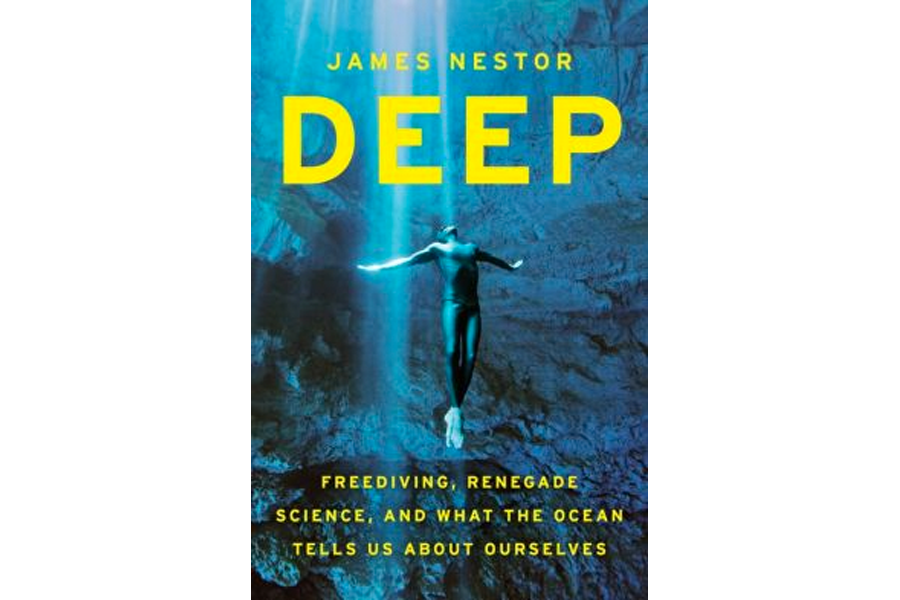'Deep' explores the extraordinary connections between humanity and the ocean
Loading...
Most people know that if you dive too far into the ocean wearing scuba gear and then resurface too quickly, you’ll find yourself at risk of death from nitrogen bubbling in your blood – a condition colloquially known as the bends. But it’s a lesser-known fact that the human body has something called the Master Switch of Life, a set of physiological resources that allow humans who dare to take the plunge to shrink their lungs, numb their senses, and protect their organs so they can dive hundreds of feet below the ocean with no oxygen tank and resurface with few ill effects.
The Master Switch of Life is one of the many ways that James Nestor’s fascinating book Deep: Freediving, Renegade Science, and What the Ocean Tells Us About Ourselves explores the extraordinary connections between humanity and the ocean.
Nestor first became intrigued by the ocean when he was sent to cover a freediving competition in Greece and witnessed a diver journey 30 stories below the ocean on a single lungful of air. Nestor began to research freediving and the scientists who are working to plumb the mysteries of the ocean, one of the last unexplored parts of our world. What he discovered was in part a call to action: Pollution is destroying the ocean, and if we don’t research it now, we may never discover its secrets and what those secrets say about the human race.
In his journey to learn about current marine research, Nestor visited a variety of different scientists around the world who are studying the ocean. He encountered researchers like Fabrice Schnöller, who’s recording the sounds of sperm whales and dolphins in an effort to decode these animals’ language and perhaps someday even facilitate communication between them and humans. He plunged thousands of feet into the ocean inside an unauthorized submarine to see bioluminescent creatures lighting up the deep sea like fireworks. He tracked down a group of deep sea divers in rural Japan called the ama, the last heirs to the ancient Japanese practice of diving deep below the sea to gather pearls, sponges, or sea urchins.
Much of the science Nestor encountered on his trip is considered renegade or DIY science. Nestor explains that most institutionally sanctioned marine researchers use robots to explore the ocean’s depths and never actually plunge into the ocean themselves. The scientists he describes in “Deep” are a different breed, often building their own equipment and taking risks that an academic institution would never sanction, such as diving with sperm whales.
Nestor also encountered freedivers who push themselves to the physical limit, often with devastating physical consequences. He was present in August 2013 when an Austrian freediver’s attempt to shatter a record went awry, and the freediver emerged with bulging veins and puffy eyes and had to be placed in an induced coma. Nearly a year later, he is still suffering from the effects of that dive. As much as Nestor respects the scientists who eschew academia’s ivory tower to explore the ocean, he also condemns freedivers who are only interested in competition, as he comes to believe that freediving should be a meditative way to commune with and explore the ocean.
In addition to describing fascinating scientific discoveries about the ocean, “Deep” is also a personal account of Nestor’s journey to overcome his fears and master the art of freediving himself. He was traumatized by the bloated faces and bloody noses at his first freediving competition in Greece, and terrified of sharks and other denizens of the ocean. He flailed around in expensive diving gear deep-sea diving with the Japanese ama and struggled to dive at a freediving training pond in Florida. But finally, while on a boat with whale-researching scientists, he was able to overcome his fears, flip the Master Switch of Life and deep-dive into the ocean.
Most of Nestor’s narrative is fascinating, as he describes some of the physical trials and risks that these scientists endure to study the ocean. But perhaps the most intriguing aspects of his book are the parts where he explores what the ocean tells us about ourselves. Nestor describes a program called FlashSonar that helps blind people navigate using only the same echolocation sense that dolphins and whales have been using to navigate in the ocean dark for millions of years. He also explores whether humans have the same ability as mollusks, sharks, and dolphins to attune to the earth’s magnetic field and access an innate sense of direction.
Ultimately, Nestor argues that studying the ocean can help us understand the important and majestic creatures that live in the deep, but it can also help us understand fundamental truths and secrets about ourselves – if we’re willing to push to the limits and look.
Emily Cataneo is a Monitor contributor.








